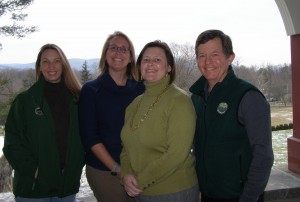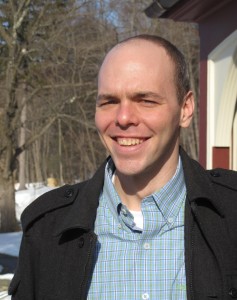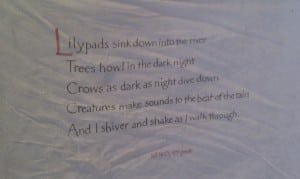HHLT adds new land stewardship staff member
By Mary Ann Ebner
Conservation easements contain much more than easy overtures. Even Andy Chmar, Hudson Highlands Land Trust executive director, didn’t fully understand conservation easements until he signed on himself to help preserve undeveloped land in the North Highlands. Those days were before Chmar started scouting the Hudson Highlands to carry out the HHLT mission to preserve clean air and water, natural habitats, local food resources and scenic beauty.
According to the Land Trust Alliance, of which HHLT is an accredited member, the fiscal cliff deal recently passed by Congress renewed conservation easement income tax deductions for 2013 and retroactively to 2012. The Land Trust Alliance noted that by removing a property’s development potential, a conservation easement could impact the value of the property, typically lowering it. The incentive may not only help landowners with taxes, estate planning and charitable giving, but may also help land preservation endeavors.

“With conservation easements, in many cases, the owner has taken a federal tax deduction, and the public at large is paying for that deduction,” Chmar said. “We (HHLT) now need to make sure there are no violations to this agreement.”
Legal agreements between landowners and HHLT permanently designate the land for conservation and limit use to preserve values. HHLT not only identifies and approves conservation easements but monitors agreements for abuse and violations. In exchange for tax breaks, landowners must meet a series of markers based on a ranking list outlined in the land trust’s Legacy Landscapes Project and then abide by restrictions outlined in conservation easements.
With the advent of HHLT’s Legacy Landscapes Project, the land trust designed a more strategic approach to prioritizing land that meets markers for full preservation consideration. Solidifying a conservation easement marks the beginning of a permanent legal agreement, and with that comes a labor-intensive commitment. In addition to researching prospective properties, the HHLT staff continues to maintain responsibility for its existing 72 conservation easements. HHLT’s Director of Land Preservation Katrina Shindledecker oversees conservation easement stewardship.
“The IRS expects us to monitor the conservation easements annually,” Chmar said. “In many respects, Katrina (Shindledecker) has been doing the job of two people. We prepare a baseline document report for each property, and that document is updated each time we visit the property.”
Property visits, which are mandated annually, can reveal topographical changes, forestation, invasive species, or any number of encroachment issues that deviate from agreements in a property’s conservation easement.

“With most cases, these issues are resolved with a phone call or a letter,” Chmar said. “We partner with the owner to get the issue remediated. In most cases, it’s not been the property owner, but an adjoining owner who has done something that encroaches on the property.”
MJ Martin, HHLT director of Outreach and Development, said that the organization takes a proactive approach to upholding their end of agreements.
“One of the benefits that we have of being a local land trust,” Martin said, “is that our staff is out in the community. We hear about things and we can address them.”
Founded in 1989 and growing in acreage and community participation, HHLT recently conducted an extensive search to hire a full-time stewardship coordinator to help address concerns and assess conservation prospects. Every project that the land trust engages in is expensive to assess and impacts the land trust, the local municipality and the public. HHLT has named Matt Decker as the organization’s new stewardship coordinator, bringing the organization’s full-time staff to five employees. Decker will be based at the nonprofit’s offices at Winter Hill in Garrison, reporting directly to Shindledecker.
“Our new employee (Decker) is a recent graduate of the Yale School of Forestry and Environmental Studies,” Chmar said. “He’ll provide stewardship for 1,700-plus acres that preserve land for conservation easements.”
Chmar said that Decker’s expertise in natural resources management, geographic information systems and field work would increase the organization’s ability to protect the region’s natural resources and manage the stewardship of the land trust’s conservation easements. The HHLT Board of Directors anticipates that the newly created stewardship coordinator position will be underwritten in part by a grant from the Land Trust Alliance, but Chmar said that the decision to move forward with the staffing addition was wholly supported with or without the grant.

Martin said that in addition to the 200-plus properties that the land trust is currently focused on assessing through its Legacy Landscapes Project, the organization is furthering outreach and community collaboration in the Hudson Highlands.
“One of the cornerstones of our community outreach is our ‘Take-A-Hike!’ program,” Martin said. “This year’s hikes will take place on both sides of the river and will range from family friendly to expert adventure level. We’ve got such a wealth of outdoor experts and volunteer historians to lead the hikes, and we wind up attracting hundreds of hikers throughout the season.”
Though hikes are open to the public, events often fill to capacity. And some hikes are for members only, publicized in membership announcements. Though membership may sound select, it’s anything but exclusive. Anyone can sign up, and as long as they provide an email or mailing address, HHLT will keep them on the membership roll (currently at 1,002 but changing continuously). Chmar noted that the organization welcomes new members with appreciation, and there is no charge to join.
“We decided we don’t want to place any hurdles in front of anyone,” Chmar said. “We set the bar so low it’s on the ground. We’ve even got people far away, even one in Arizona, who made a contribution because he loves it up here.”
Though membership is free, contributions are welcome and essential. Land conservation serves as the heart of the organizational mission, but outreach, public policy efforts and education round out mission objectives. To fuel those efforts, the organization relies on contributions. It’s not unheard of to see the hat passed around at HHLT hikes and other events where participants may donate a few bills. But collections from hat passing are largely supplemented by significant contributions and grants, and during the 2011 fiscal year, HHLT received 27 percent of total contributions from two contributors. In 2012, one contributor donated 19 percent of the land trust’s total contributions.
Like many nonprofits, much of the HHLT operating budget is designated to support program services. In fiscal years 2012 and 2011, expenses for program services totaled $584,576 and $581,490, respectively, with an increase in 2011 of $135,121 over fiscal year 2010. In addition to the “Take-A-Hike!” program, 2013 program services allocations will fund environmental educational programs including “River of Words,” which promotes literacy and environmental land stewardship to school children in the five school districts of Haldane, Garrison, Putnam Valley, Cornwall and Highland Falls/Fort Montgomery.
“Spring is a fantastic time for environmental education,” Martin said. “Our environmental educators are working right now indoors, but we are usually incredibly booked when the crocuses are waking up. Irene O’Garden (environmental educator) is doing a three-day poetry intensive language arts component for fourth and fifth graders, and any teacher in all five of our school districts can request our programs.”
HHLT will also orchestrate a teacher-training seminar this spring. The seminar will be held May 17 at their office and outdoor space at the 30-acre Winter Hill, where HHLT relocated as a tenant in 2012 along with the Hudson Valley Shakespeare Festival and the Garden Conservancy.

“We’re doing a full-day teacher training for elementary and middle school teachers,” Martin said. “This is the first time we’ve done something this comprehensive, and it will be a day of training to work outdoors with children to learn to use nature as a learning environment.”
The 2013 calendar will also include a sustainability community forum on invasive species, to be held in April at Highlands Country Club.
Family Festival, the annual sleepover under the stars, also returns in 2013. Working in conjunction with the Haldane School Foundation, the Garrison Children’s Education Fund and Philipstown Recreation Center, the event welcomes experienced and first-time campers and will be held June 8 at the Claudio Marzollo Community Center.
HHLT will continue to focus on cleanups throughout the year and help champion the environmental cause on both sides of the Hudson. Membership and Public Policy Coordinator Kathy Hamel regularly attends community meetings in the Town of Highlands, and HHLT endeavors to be available as a resource.
“It’s a step-by-step process,” Hamel said. “They struggle with some of the same issues as Philipstown, and we’re always here to help them beautify and green the community.”
The local land trust continues to advocate public policy for the preservation of open space and natural resources. Short-term opportunities to voice opinions with HHLT take place March 6 with Environmental Protection Fund Lobby Day and March 13 with American Farmland Trust Lobby Day in Albany.
In allocating resources to further environmental public policy, community awareness, educational programming and land conservation, the local land trust is growing its presence in Philipstown and vetting the community for a sustainable future.
Organization: Hudson Highlands Land Trust
Office location: Winter Hill, 20 Nazareth Way, Garrison
Postal Address: P.O. Box 226, Garrison, NY 10524
Website: hhlt.org
Phone: 845-424-3358
E-mail: [email protected]
Executive Director: Andrew T. Chmar
Chairman: Christopher Davis
Number of employees: Five full-time employees, small staff of part-time educators, countless volunteers with room for more to help with a variety of indoor and outdoor events and programs
Fiscal Year ending Sept. 30, 2012 Operating Revenues: $837,919, Operating Expenses: $722,452
Fiscal Year ending Sept. 30, 2011 Operating Revenues: $678, 220, Operating Expenses: $673,065
Number of conservation easements: 72
Land currently preserved: 1,700+ acres
